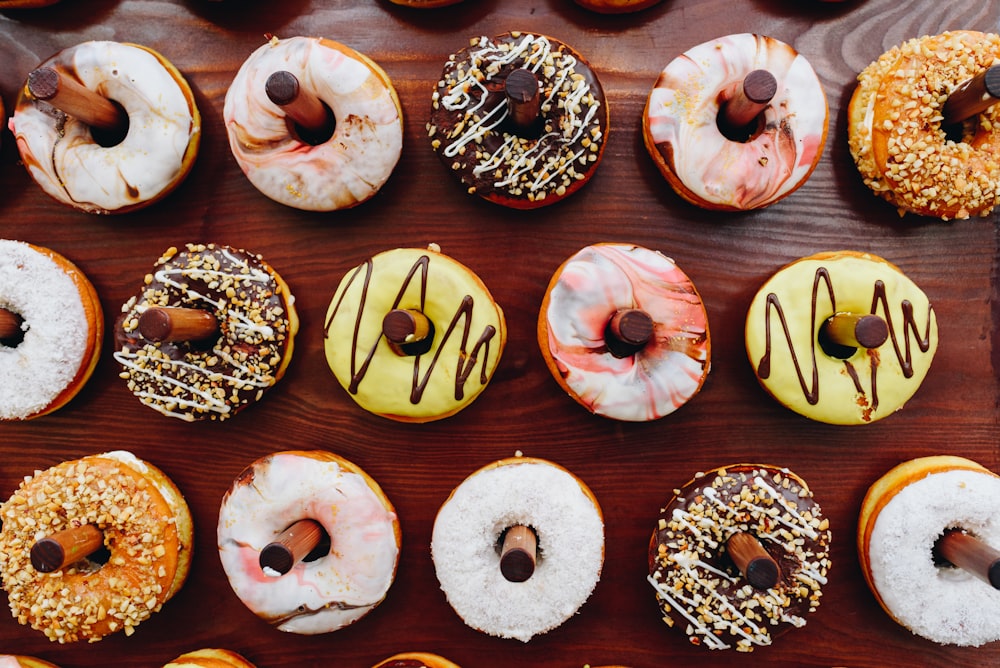
If you feel like you need to learn how to break a sugar addiction in order to start eating healthier, you’ve come to the right place. If you think you might be addicted to food or battling an eating disorder, you may need to consider professional help. Learning how to break a sugar addiction on your own, for example, might be difficult without some outside help.
If you’re looking to start with steps you can commit to on your own, to manage sugar cravings, the following steps might help. To begin, let’s discuss trigger foods and the role they play in sugar addiction.
Identify Your Trigger Foods

Not all of us struggle with the same food triggers. The foods with which some of us completely lose control, others do just fine. In fact, your genes play a part in determining the degree of sugar addiction. Although a DNA test can help you determine if you’re more prone to getting a sugar addiction, you can also simply pay attention to your eating habits.
The first step to break your sugar addiction is to identify which foods, specifically, you struggle with. You might find that a food journal comes in handy, here. Write down what you eat, how much of it you eat, and if you have trouble stopping. This doesn’t have to be some detailed account of foods and calories, as it might simply be a record of what you eat and why.
You might write down how you felt before, during, and after eating different foods. In your journal or food diary, you could also write about any occasions of binge-eating, where you ate one of something, and just couldn’t stop.
Get a crystal-clear picture of which foods or types of foods are causing you the most trouble. Reflect on the situations, times, places, thoughts, and feelings that are often present when your cravings kick in.
Often, we turn to food for distraction, coping, entertainment, stress relief or comfort. Be honest with yourself and work to cultivate a sense of self-awareness.
Doing so might help you practice self-control, build confidence and self-esteem, and make better decisions.
Once you’ve identified your triggers, start planning for how to address them.
Consider Moderation or Abstinence

“Eat all foods in moderation” is common advice for making dietary changes. For some of us, this is a great approach. We find that when we become too restrictive with our eating habits, we’re more likely to binge.
Some of us, however, are horrible at moderation.
We simply find it easier and less stressful to say “no” than to eat “just one”.
Furthermore, in the context of food addiction, the advice to “eat all foods in moderation” can be counterproductive.
You’ll want to find the approach that works best for you.
If you’ve been trying either of these approaches and are struggling, consider trying the other.
Regardless of which approach you choose, you might find it helpful to not keep trigger foods at home.
Putting some friction between yourself and potentially problematic foods might make all the difference in the world.
Next, we’ll cover steps you can take with your diet in general to manage hunger and cravings.
Eat to Stay Satisfied
Another step that might help is dialling in the rest of your diet to control your appetite.
Eat Slowly
Without changing what you eat, changing how you eat can help you control your appetite and break your sugar addiction.
Eat slowly, chew thoroughly, and pay attention to your food. Eating slowly might help you eat less without feeling hungrier.
Chewing thoroughly also might help you eat less, and promote the release of digestion and satiety hormones.
Paying attention to what you’re eating and reflecting on what you’ve already eaten might help you eat less in the immediate moment and also later in the day.
Make Protein the Foundation of Every Meal

Eating more protein promotes higher metabolism, feeling more full, and losing more fat – not precious muscle, organs, or other lean mass tissue – when losing weight.
Animal sources like meat, dairy, fish, and eggs typically offer more digestible, bio-available, complete amino acid profiles, plus a wide range of nutrients not found in plant sources.
You’ll likely look, feel, and perform your best with somewhere around a gram of protein per pound of body weight.
This usually looks like one or two palm-sized servings of protein with each meal, assuming three or four meals per day.
Fill up with Minimally-Processed Carbs and Fats

Regardless of whether you prefer more fat and fewer carbs or vice versa, eating minimally processed food can help you keep your hunger in check.
For example, in a 2019 trial, participants freely eating ultra-processed foods consumed 500 calories more per day than those freely eating unprocessed foods with the same nutrient profile.
Examples of minimally processed fat sources are beef, lamb, eggs, nuts, seeds, olives, avocados, and fatty fish like salmon.
For carbs, you might choose fruit, berries, root vegetables, tubers, and properly-prepared grains and legumes, if you tolerate them.
Drink Water, Tea, or Other Non-Caloric Beverages

Calories in liquid form, including sugary drinks, don’t affect our hunger and satiety signals the same as solid food, and can promote excessive energy intake and weight gain.
Consider starting each day with 30 – 40 oz. of plain water immediately upon waking.
From there, prioritize non-caloric options like more water, unsweetened tea, plain black coffee, or drinks flavoured with other sugar substitutes.
You might find flavoured carbonated waters like LaCroix to be a nice non-caloric option.
If you prefer something sweeter, you might enjoy a stevia-sweetened soda alternative like Zevia.
That all being said, food and drink aren’t the only factors affecting your appetite.
Prioritize High-Quality Sleep

One factor other than food that might be playing a role in your cravings is poor sleep.
Sleep deprivation appears to affect our nervous systems in ways that drive our appetite for high-calorie foods.
Even one night of sleep curtailment may promote increased hunger, cravings, food reward, and portion sizes.
To make sure poor sleep isn’t contributing to your cravings for sugar, consider the following steps:
- The American Academy of Sleep Medicine recommends setting a bedtime that allows for 7 hours of sleep, establish a relaxing bedtime routine, keep your bedroom quiet, comfortable, and cool, and use your bed only for sleep and sex.
- Practice good sleep hygiene, including regular exercise, manage stress, reduce noise, set a consistent bedtime, and avoid caffeine, nicotine, alcohol, and daytime napping.
- Get plenty of bright light early and throughout the day, while minimizing bright light – especially from artificial lighting, smartphones, and screens – at night.
- If you must use screens at night, consider wearing amber-colored blue light blocking glasses for 2 hours before heading to bed.
- Make sure you’re eating enough, particularly protein and carbohydrates, and consider supplementing with melatonin, GABA, or glycine.
Manage Stress

Another factor that might be playing a role in making a sugar addiction more difficult to break is stress.
One of the primary drivers of stress causing weight gain is the cravings it can promote.
What makes this such a challenging obstacle to overcome is that we can’t always eliminate our sources of stress.
Sure, we could cut ties, quit our jobs, and move to the tropics to open a coconut farm.
However, most of us have bills to pay, mouths to feed, and people who depend on us.
So, rather than dropping everything and removing ourselves from society, we can take small steps each day to better manage our stressors.
Establish a Mindfulness Practice

One strategy for managing stress is establishing a mindfulness practice.
Mindfulness is paying attention to the immediate moment, intentionally, and with curiosity and compassion, not judgement.
One area where a regular mindfulness practice really shines is in its ability to promote self-control when making changes to improve your health.
Perhaps most relevant to break your sugar addiction or cravings, mindfulness might help reduce binge eating, impulsive eating, and restrained eating.
One popular mindfulness practice, meditation, appears to improve not only stress, but also anxiety, depression, pain, and other aspects of mental health.
Some popular ways to practise mindfulness are:
- Paying attention to bodily sensations (a “body scan”).
- Focusing on breathing, sounds, thoughts, feelings, and emotions.
- Tuning in to feelings and observations while walking, standing, or yoga, or even brushing your teeth, taking a shower, or eating.
- Practicing separation from thoughts (“thoughts are not facts” or “I am not my thoughts”).
Breathe Deeply
Another stress management technique you might consider is breathing deeply.
Extending your exhalations, breathing slowly, and diaphragmatic breathing might help you relax, reduce stress, increase mindfulness, improve mood, and regulate stress hormones.
Breathing deeply might not be the most exciting strategy in the world, but every little step adds up.
It’s those little steps, taken consistently, that move us forward.
Aim for Consistency, Not Perfection

There’s a ton of evidence pointing to consistency as one of the most important factors in improving one’s health through dietary changes.
For example, a 2018 experiment demonstrated that consistently eating minimally processed foods was a more important factor than whether individuals restricted carbs or fats, even those who appeared to genetically or metabolically favour one or the other.
Similarly, a study in 2005 and two studies in 2009 showed adherence to be more important for improving health and body composition than relative amounts of carbs, fats, and protein is eaten.
Consistency isn’t only an important factor in our initial success, but also for maintaining it.
Yet, we seem to have a harder time keeping up healthier eating habits than we do give up alcohol, cocaine, heroin, smoking, or gambling.
Fortunately, there are steps you can take to be more consistent with your efforts.
One way to increase your consistency is to focus on building habits.
Rather than “going on a diet” – a short-term mindset that relies on willpower and often fails in the long term – aim for building habits you can make part of your lifestyle with less conscious effort.
Other strategies to help you with long-term adherence are seeking regular coaching or guidance, learning to identify and address potential challenges, and recruiting social support.
Stay flexible and align any new eating habits with your personal preferences.
Consider planning your meals and keeping a food log or journal.
Have Self-Compassion

Finally, don’t be so hard on yourself. Remember that you’re not perfect and you never will be. That’s a part of being human.
Don’t ruminate over what you like or dislike about yourself, including your challenges with breaking your sugar addiction.
Practising some self-compassion can help you in a variety of ways:
- Greater motivation to pursue health goals.
- Adaptive coping strategies that help you move toward these goals.
- Self-kindness that drives the desire to take care of your body.
- Understand that everyone makes mistakes, fails to reach goals, and experiences misfortune.
- Less self-criticism, shame, and stress that might make you give up or quit.
Remember that your food choices are not a measure of your value.
Don’t do any of this in an effort to be worthy of love. Do it because you already are worthy of love. That starts with loving yourself.
It starts with seeing yourself as the awesome person that you are.
This includes all your flaws and weaknesses.
They’re part of what makes you “you”.
You’re a complex human being with competing wants and desires. You can value yourself and your health but also find sugar delicious at the same time. It just might take some work to reconcile those two parts of who you are.
You’re worth that work. Take one step at a time. Do what you can. You’ve got this.
From CircleDNA:
If you’d like to find out through DNA testing whether or not you’re likely to have better or worse appetite control, and what your optimal diet is based on your genetics, click here to get a DNA testing kit.






